Copyright 2013 Houghton Mifflin Harcourt Publishing Company
All rights reserved
www.hmhbooks.com
cliffsnotes.com
No part of this work may be reproduced or transmitted in any form or by any means, electronic or mechanical, including photocopying and recording, or by any information sotrage or retrieval system without the prior written permission of Houghton Mifflin Harcourt Publishing Company unless such copying is expressly permitted by federal copyright law. Address inquiries to Permissions, Houghton Mifflin Harcourt Publishing Company, 215 Park Avenue South, New York, New York 10003.
The publisher and the author make no representations or warranties with respect to the accuracy or completeness of the contents of this work and specifically disclaim all warranties, including without limitation warranties of fitness for a particular purpose. No warranty may be created or extended by sales or promotional materials. The advice and strategies contained herein may not be suitable for every situation. This work is sold with the understanding that the publisher is not engaged in rendering legal, accounting, or other professional services. If professional assistance is required, the services of a competent professional person should be sought. Neither the publisher nor the author shall be liable for damages arising here from. The fact that an organization or Website is referred to in this work as a citation and/or a potential source of further information does not mean that the author or the publisher endorses the information the organization or Website may provide or recommendations it may make. Further, readers should be aware that Internet Websites listed in this work may have changed or disappeared between when this work was written and when it is read.
Trademarks: CliffsNotes, the CliffsNotes logo, Cliffs, cliffsnotes.com, and all related trademarks, logos, and trade dress are trademarks or registered trademarks of Houghton Mifflin Harcourt Publishing Company. All other trademarks are the property of their respective owners. Houghton is not associated with any product or vendor mentioned in this book.
Library of Congress Cataloging-in-Publicaation data is available.
ISBN 978-0-7645-8510-4
eISBN 978-0-544-18417-6
v1.0612
Life and Background of the Author
Lois Lowrys first book, A Summer to Die, was published in 1977. Since then, she has written over twenty novels for young adults and has won numerous awards, including two prestigious Newbery awards, one for Number the Stars and the other for The Giver. Lowry doesnt rely on awards to determine her success as a writer but, rather, on how well she communicates with her readers about individuality, life, and relationships. Her books portray sensitive, intelligent, witty protagonists who are faced with challenges and choices in life. She writes about topics that range from the humorous escapades of Anastasia Krupnik to Jonas serious realization in The Giver that he has been living his life like a robot.
Lowry was born on March 20, 1937, in Honolulu, Hawaii, to Robert E. Hammersberg, a United States Army dentist, and Katherine Landis Hammersberg. Because her father was a career army officer, Lowry often moved during her childhood. From Hawaii, her family relocated to New York, and during World War II, she, her mother, and her older sister, Helen, lived with her mothers family in Pennsylvania while her father was stationed overseas. During this time in Pennsylvania, Lowrys grandfather showered her with attention and affection, but her step-grandmother merely tolerated her. Because Lowry was a shy, introverted child, she sought companionship and entertainment in the wonderful worlds that existed within the books she found in her grandfathers library. After the war, Lowry and her family joined her father in Tokyo, Japan, where they lived for two years in an Americanized community.
At the outbreak of the Korean War in 1950, Lowry returned to the United States to attend a small, private high school in New York City. She graduated from high school in a class of close to fifty students. The caption under her senior picture in the school yearbook reads, Future Novelist. The following fall, Lowry entered Pembroke College, a branch of Brown University, in Rhode Island, to pursue her childhood dream of becoming a writer. She completed her sophomore year of college, and then, at the age of nineteen, she did what so many other women did during the 1950s: She set her studies aside to get married. Because her husband, Donald Lowry, was a naval officer, Lowry resumed a military lifestyle that included traveling and living wherever her husband was stationed. She and her husband lived in California, Connecticut, Florida, and South Carolina, and when her husband left the service to attend Harvard Law School, they moved to Cambridge, Massachusetts. After her husband finished law school, the Lowry family, which now included four children, settled in Portland, Maine. Lowry eventually received a bachelors degree in 1972 from the University of Southern Maine and then immediately began work on a masters degree.
While attending graduate school, Lowry established herself as an accomplished freelance journalist. She began writing stories and articles that appeared in publications such as Redbook, Yankee, and Down East, as well as in newspapers. She also edited two textbooks Black American Literature (1973) and Literature of the American Revolution (1974), both written by J. Weston Walshand became a photographer, specializing in photographs of children. In 1978, a collection of her photographs of buildings and houses was published in a book titled Here at Kennebunkport.
Lowrys first novel, A Summer to Die (1977), is about the relationship between two adolescent sisters, Meg and Molly, and the effect that Mollys death, as a result of leukemia, has on the family. Lowry based the relationship between Meg and Molly on her own memories of her relationship with her older sister, Helen, as they were growing up, and on the feelings and emotions that she felt when Helen died of cancer. Lowry experienced other heartaches, as well. Grey, her oldest son and a fighter pilot in the United States Air Force, was killed in a plane crash. In addition, Lowry has a daughter who became disabled as a result of a disease involving the central nervous system. Her daughters disability has reinforced Lowrys belief that people are connected despite their physical differences.
In 1977, Lowry and her husband divorced, and Lowry remained in Maine for the next two years, continuing to write. After completing another serious novel, Find a Stranger, Say Goodbye (1978), Lowry moved to Boston. Because she had been writing about serious and sad issues, she decided to write a humorous short story about a ten-year-old girl named Anastasia Krupnik. Anastasia is a gangly girl who wears glasses, has messy blonde hair, and is always getting into mischief. Lowry liked Anastasia and her family so much that the short story became the first chapter of her novel Anastasia Krupnik (1979), the first in a series of novels about Anastasia.
Lowry divides her time between her house in Cambridge, Massachusetts, and her nineteenth-century farmhouse in New Hampshire. When she isnt at her desk writing, she likes to garden, cook, and knit. She enjoys reading memoirs and biographies, taking exotic, adventurous trips, and going to as many movies as possible. She writes for about five hours each day, working on more than one project at a time. Although her novels cover a variety of topics and range in tone from serious to humorous, they share many of the same themes: individuality, freedom, and the importance of memory. Through her writing, Lowry communicates the message that people must be aware that everything they do affects other people, the environment, and the world.
Next page








